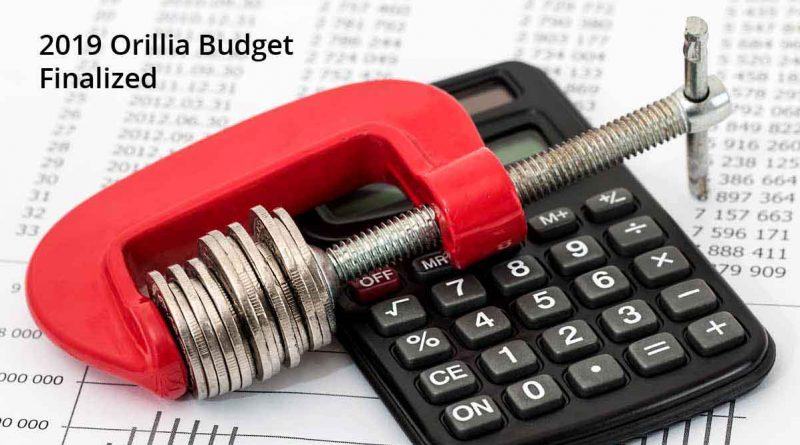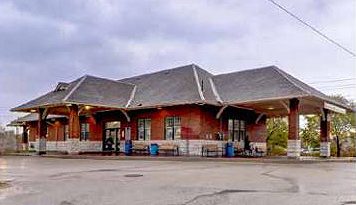Orillia Property Taxes Going Up
By John Swartz
Tuesday afternoon Orillia council ended an exercise to set the 2019 budget with a 3.249% increase taxpayers must face.
Councillors began the process of vetting staff’s recommended spending with a planned 2.9% increase at its Jan. 14 meeting. The following Monday at its regular council meeting they added funding requests from Mariposa House Hospice, the Sharing Place Food Bank and Soldiers’ Memorial Hospital to the long list of items for consideration. Those new requests threatened to add 1.2% more to tax bills if councillors didn’t find other things to cut, or allocate money from reserves.
The budget is in two parts, operating and capital. The first relates to the things needed to run day to day business, pay staff, and operate programs. The capital budget is for purchase of equipment and construction projects. The capital budget is $30 million, but only $1.9 million is part of the tax levy, with the rest coming from grants from other levels of government and reserves.
When the last budget page was disposed of, there were still three things to decide before the amount of tax bills could be determined. Council ended the operating part of the budget over spending by $166,000, and the capital part under spending by $92,000.
One would naturally think one figure would offset the other and council would only have to add the difference to the tax levy, but treasurer Jim Lang gave a lengthy explanation why that wasn’t a good idea. It boiled down to robbing Peter to pay Paul next year at two times the amount because the base operating budget would start with an increase of some amount up to $166,000, plus a contribution to reserves to make up spending that amount this year.
At the last recess before dealing with three motions about the surplus budget approvals, and Environmental Assessment and design work for Laclie Street reconstruction (which would only lower spending if Councillor Tim Lauer’s plan got approval) mayor Steve Clarke told the press gallery the original 2.95% was made up of 2.8 percent council previously directed to increase reserve contributions, meaning the base operating and capital budgets were only increased by .15% because of spending cuts staff found before presenting the budget to council.
The increase contributions to reserves were started as an annual move by the last council to make up for unfunded borrowing from reserves that occurred before the 2014 term. Treasury regards much of the spending from reserves which took place as the City borrowing from itself because reserves were accumulated for specific reasons (future capital projects mainly) and need to be replenished somehow for when its time to put those projects in motion.
The City does have a substantial operating surplus from 2018, which Lang believes, when the final accounting is done, will be about $2 million. Most is already allocated to the tax rate stabilization reserve, from which council could have taken the money to get back down to the planned $2.95% increase.
Lang pointed out $65,000 of the operating budget overage was for one time spending and if it was allocated from reserve it would not negatively affect the 2020 budget. A motion to that effect failed.
The $92,000 under spending was ultimately allocated to a capital contingency reserve, and the tax levy increase when everything was done remained at 3.249%. The final amount of money required from property taxes for operating and capital combined is $58,199,899, or $1,877 per resident (not taxpayer).
This means residents can expect for every $100,000 of assessment on their property, taxes will go up $39.65. Based on recent MLS statistics, the average price of homes sold in Orillia is $490,000; if that were taken as an assessment value, the tax increase for such a house would be $194.29 annually.
In context, mayor Clarke mentioned Barrie announced on Tuesday their tax levy increase was 2.88%, of which one percentage point was specifically for reserve fund contributions. It was also noted that among comparator communities, Orillia’s taxes are in the middle of the range.
The increase also compares to the 2018 consumer price index increase of 2.4% and the 2018 Canadian inflation rate of 2.2% (both are different measures). Lang also told SUNonline/Orillia he had to contend with a 5.2% increase in the Stats Canada construction cost index in figuring how to budget for 2019.
New Water Rates
The increases don’t stop with the tax bill. Water and sewer rates are going up.
The 2019 water rate is going from $8.01 for the basic monthly fee and $1.47 per each cubic meter (about 2,000 average sized water bottles) used in 2018 to $9.24 basic and $1.52 usage for residences starting March 1. Council also adopted rates for 2020 of $10.64 and $1.57. Commercial rates are structured into several tiers and start at higher figures; they are going up accordingly.
Sewer rates are going from $8.01 basic monthly rate and $1.77 per cubic meter to $9.24 and $1.82 in 2019. Council also adopted increases for 2020 of $10.46 and $1.88. The new estimated 2019 average bill for water and sewer is $756.16, up from $710.64.
The water and sewer amount collected annually is $2 million short of needs for the next 20 years. Instead of jumping to full cost recovery, council decided in 2015 to gradually increase rates through to 2022 to make up the shortfall.
A new storm water utility rate was implemented in 2017. It forms part of taxpayer’s water bills and last year $242,000 was collected. The projected annual need is $3,250,000 to fund maintenance and upgrades through to 2036. This much is needed because of known repairs and new facilities, and also in anticipation the province will be requiring municipalities to filter and treat storm water (in the waste water treatment stream) before it’s allow into waterways like Lake Couchiching where most of Orillia’s storm runoff goes now.
In light of the huge gap in funding needs, which traditionally – and for many municipalities still – comes from the tax levy, councillor Lauer wanted the rate increase from $.88 per month ($10.39 for commercial/industrial) to $1.94 per month ($22 commercial/Industrial) in 2019, and to $3 and $33.61 respectively in 2020 to be 2 or 3 times higher. If the full cost was assessed residential rates would be $9.60 residential and $113.10 commercial/industrial monthly.
A Note About Coverage
SUNonline/Orillia will have a number of stories analyzing aspects of the operating, capital, and board and committee budgets (with some insight of their 2019 plans) – what got approved and what didn’t get approved – in the days ahead. Council has a special meeting Feb 4 at 7 p.m. to ratify budget committee decisions, and for a zoning by-law amendment regarding 460 West Street South.
(Image – stevepb Pixabay )




